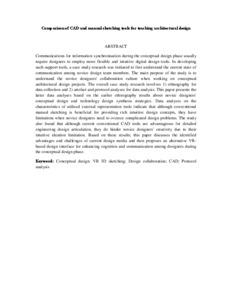Citation
Ibrahim, Rahinah and Rahimian, Farzad Pour
(2010)
Comparison of CAD and manual sketching tools for teaching architectural design.
Automation in Construction, 19 (8).
pp. 978-987.
ISSN 0926-5805; ESSN: 1872-7891
Abstract
Communications for information synchronisation during the conceptual design phase usually require designers to employ more flexible and intuitive digital design tools. In developing such support tools, a case study research was initiated to first understand the current state of communication among novice design team members. The main purpose of the study is to understand the novice designers' collaboration culture when working on conceptual architectural design projects. The overall case study research involves 1) ethnography for data collection and 2) artefact and protocol analyses for data analysis. This paper presents the latter data analyses based on the earlier ethnography results about novice designers' conceptual design and technology design synthesis strategies. Data analyses on the characteristics of utilised external representation tools indicate that although conventional manual sketching is beneficial for providing rich intuitive design concepts, they have limitations when novice designers need to oversee complicated design problems. The study also found that although current conventional CAD tools are advantageous for detailed engineering design articulation, they do hinder novice designers' creativity due to their intuitive ideation limitation. Based on these results, this paper discusses the identified advantages and challenges of current design media and then proposes an alternative VR-based design interface for enhancing cognition and communication among designers during the conceptual design phase.
Download File
![[img]](http://psasir.upm.edu.my/13683/1.hassmallThumbnailVersion/Comparison%20of%20CAD%20and%20manual%20sketching%20tools%20for%20teaching%20architectural%20design.pdf)  Preview |
|
Text (Abstract)
Comparison of CAD and manual sketching tools for teaching architectural design.pdf
Download (36kB)
| Preview
|
|
Additional Metadata
Actions (login required)
 |
View Item |

